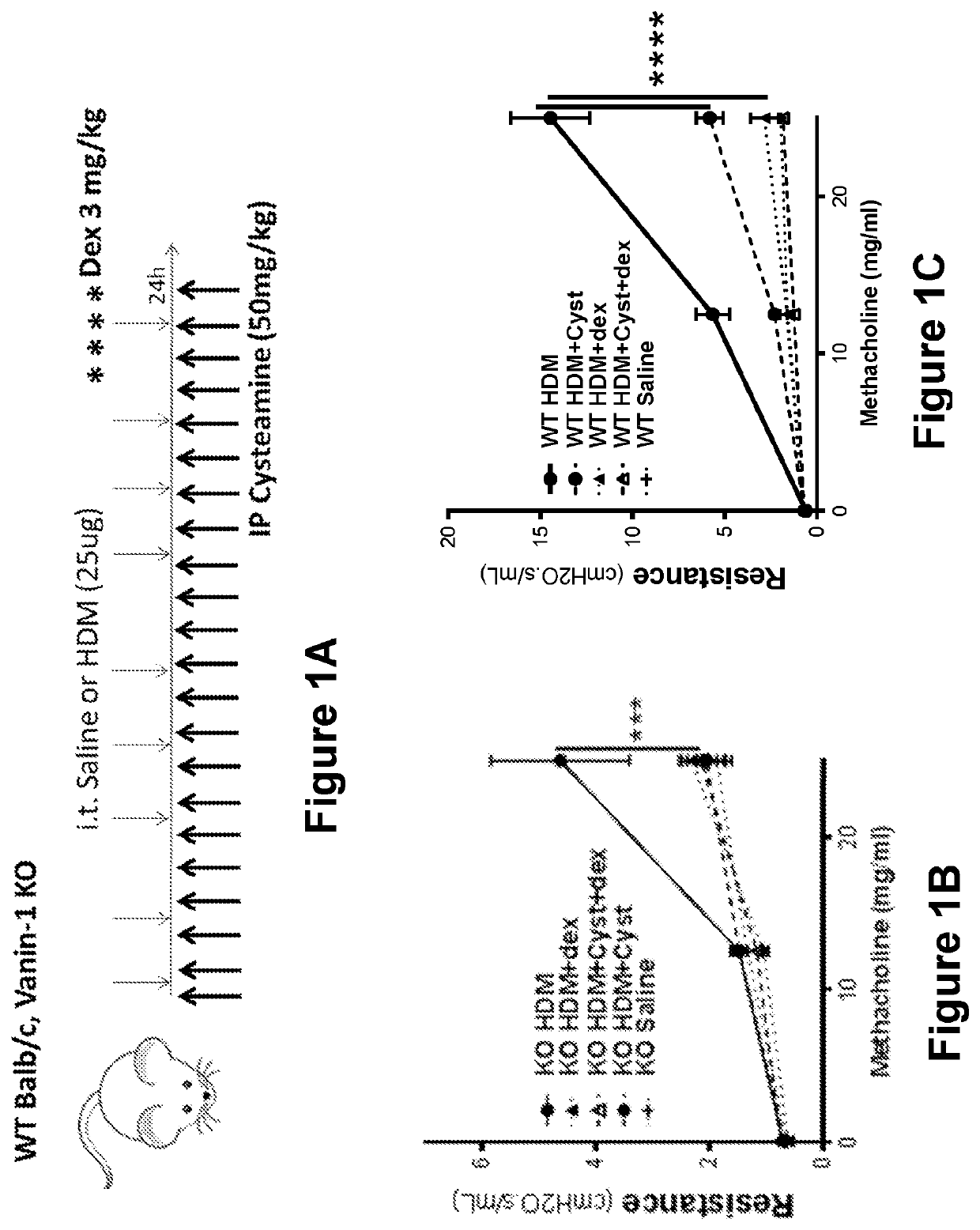Treatment of asthma with cysteamine
- Summary
- Abstract
- Description
- Claims
- Application Information
AI Technical Summary
Benefits of technology
Problems solved by technology
Method used
Image
Examples
example 1
tic Treatment With Cysteamine Significantly Prevents Asthma Development
[0101]Steroid non-responsive mice (e.g., vanin 1 (VNN1) knock-out (KO) mice) and normal mice (e.g., wild type (WT) BALB / c mice) were used in an experimental asthma model. Since VNN1 KO mice lack tissue cysteamine, these mice were used to determine whether replacement of cysteamine would be sufficient to restore responsiveness to a steroid treatment.
Methods
Treatment and Challenge Protocol
[0102]WT BALB / c and VNN1 KO mice were started on cysteamine replacement treatment (e.g., as illustrated in FIG. 1A) one day prior to the start of intratracheal (i.t.) challenges. Mice then received one intraperitoneal (i.p.) injection of cysteamine hydrochloride (50 mg / kg) or saline every day. Mice were challenged 3 times a week for 3 weeks to an allergen (e.g., house dust mite (HDM, 25 μg in 50 μl saline)) or saline. A subset of mice from each group received a corticosteroid (e.g., dexamethasone (3 mg / kg)) treatment during the la...
example 2
of Cysteamine Therapeutic Treatment for Asthma
[0105]As shown in Example 1, cysteamine replacement decreased asthma in both WT and VNN1 KO mice. It was next sought to evaluate the effectiveness of cysteamine treatment after asthma is already established in normal mice (e.g., WT BALB / c mice).
Methods
Treatment and Challenge Protocol
[0106]WT BALB / c mice underwent 6 intratracheal challenges to an allergen (e.g., HDM (25 μg)) to induce asthma development. Control mice underwent 6 intratracheal challenges to saline instead. The next day a subset of mice received cysteamine (50 mg / kg) treatment for seven days (on challenge days, mice received treatment 30 minutes prior to challenge). See FIG. 2A for the treatment and challenge protocol. The mice were sacrificed 24 hours after the last challenge.
Airway Responsiveness Measurement
[0107]To determine the effectiveness of the treatment, airway responsiveness was measured as follows. 24 hours after the last challenge, invasive measurements were mad...
example 3
n of Effectiveness of Cysteamine at Lower Doses to block Allergen-Induced Asthma Exacerbation
[0111]Since 50 mg / kg cysteamine treatment in Example 2 proved effective after 6 i.t. challenges, it was next sought to identify a minimal dose required to achieve a desired clinical effect such that dose-related side-effects of cysteamine can be minimized.
Methods
Treatment and Challenge Protocol
[0112]As shown in FIG. 3A, WT BALB / c mice underwent 9 intratracheal challenges to an allergen (e.g., HDM (25 μg)) over 3 weeks to induce asthma development. Control mice underwent 9 intratracheal challenges to saline instead. Once asthma was established, a subset of mice received cysteamine (e.g., Cystagon®, which corresponds to cysteamine bitartrate) at various doses (6.25, 12.5, 25, or 50 mg / kg) or saline vehicle intraperitoneal (i.p.) treatment 3 times every day for 2 weeks. On the 14th day, all mice received a single HDM recall challenge. Mice received scheduled i.p. treatment prior to airway respo...
PUM
| Property | Measurement | Unit |
|---|---|---|
| Weight | aaaaa | aaaaa |
| Weight | aaaaa | aaaaa |
| Frequency | aaaaa | aaaaa |
Abstract
Description
Claims
Application Information
 Login to View More
Login to View More - R&D
- Intellectual Property
- Life Sciences
- Materials
- Tech Scout
- Unparalleled Data Quality
- Higher Quality Content
- 60% Fewer Hallucinations
Browse by: Latest US Patents, China's latest patents, Technical Efficacy Thesaurus, Application Domain, Technology Topic, Popular Technical Reports.
© 2025 PatSnap. All rights reserved.Legal|Privacy policy|Modern Slavery Act Transparency Statement|Sitemap|About US| Contact US: help@patsnap.com



